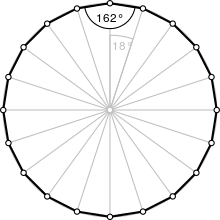Icosagon
| Regular icosagon | |
|---|---|
|
A regular icosagon | |
| Type | Regular polygon |
| Edges and vertices | 20 |
| Schläfli symbol | {20}, t{10}, tt{5} |
| Coxeter diagram |
|
| Symmetry group | Dihedral (D20), order 2×20 |
| Internal angle (degrees) | 162° |
| Dual polygon | self |
| Properties | convex, cyclic, equilateral, isogonal, isotoxal |
In geometry, an icosagon is a twenty-sided polygon or 20-gon. The sum of any icosagon's interior angles is 3240 degrees.
Regular icosagon
The regular icosagon has Schläfli symbol {20}, and can also be constructed as a truncated decagon, t{10}, or a twice-truncated pentagon, tt{5}.
One interior angle in a regular icosagon is 162°, meaning that one exterior angle would be 18°.
The area of a regular icosagon with edge length t is
In terms of the radius R of its circumcircle, the area is
since the area of the circle is  the regular icosagon fills approximately 98.36% of its circumcircle.
the regular icosagon fills approximately 98.36% of its circumcircle.
Uses
The Big Wheel on the popular US game show The Price Is Right has an icosagonal cross-section.
The Globe, the outdoor theater used by William Shakespeare's acting company, was discovered to have been built on an icosagonal foundation when a partial excavation was done in 1989.[1]
As a golygonal path, the swastika is considered to be an irregular icosagon.[2]
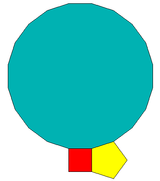 A regular square, pentagon, and icosagon can completely fill a plane vertex.
A regular square, pentagon, and icosagon can completely fill a plane vertex.
Construction
As 20 = 22 × 5, regular icosagon is constructible using a compass and straightedge, or by an edge-bisection of a regular decagon, or a twice-bisected regular pentagon:
 Construction of a regular icosagon |
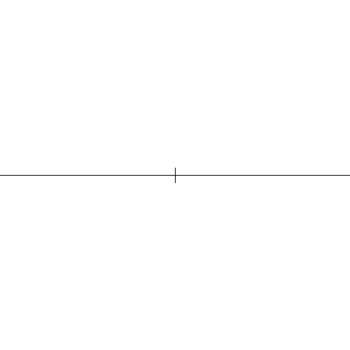 Construction of a regular decagon |
Symmetry
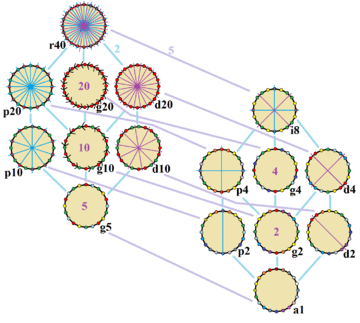
The regular icosagon has Dih20 symmetry, order 40. There are 5 subgroup dihedral symmetries: (Dih10, Dih5), and (Dih4, Dih2, and Dih1), and 6 cyclic group symmetries: (Z20, Z10, Z5), and (Z4, Z2, Z1).
These 10 symmetries can be seen in 16 distinct symmetries on the icosagon, a larger number because the lines of reflections can either pass through vertices or edges. John Conway labels these by a letter and group order.[3] Full symmetry of the regular form is r40 and no symmetry is labeled a1. The dihedral symmetries are divided depending on whether they pass through vertices (d for diagonal) or edges (p for perpendiculars), and i when reflection lines path through both edges and vertices. Cyclic symmetries in the middle column are labeled as g for their central gyration orders.
Each subgroup symmetry allows one or more degrees of freedom for irregular forms. Only the g20 subgroup has no degrees of freedom but can seen as directed edges.
The highest symmetry irregular icosagons are d20, a isogonal icosagon constructed by ten mirrors which can alternate long and short edges, and p20, an isotoxal icosagon, constructed with equal edge lengths, but vertices alternating two different internal angles. These two forms are duals of each other and have half the symmetry order of the regular icosagon.
Related polygons
An icosagram is a 20-sided star polygon, represented by symbol {20/n}. There are three regular forms given by Schläfli symbols: {20/3}, {20/7}, and {20/9}. There are also five regular star figures (compounds) using the same vertex arrangement: 2{10}, 4{5}, 5{4}, 2{10/3}, 4{5/2}, and 10{2}.
| n | 1 | 2 | 3 | 4 | 5 |
|---|---|---|---|---|---|
| Form | Convex polygon | Compound | Star polygon | Compound | |
| Image | 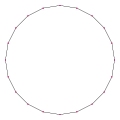 {20/1} = {20} |
.svg.png) {20/2} = 2{10} |
 {20/3} |
.svg.png) {20/4} = 4{5} |
.svg.png) {20/5} = 5{4} |
| Interior angle | 162° | 144° | 126° | 108° | 90° |
| n | 6 | 7 | 8 | 9 | 10 |
| Form | Compound | Star polygon | Compound | Star polygon | Compound |
| Image | .svg.png) {20/6} = 2{10/3} |
 {20/7} |
.svg.png) {20/8} = 4{5/2} |
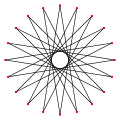 {20/9} |
.svg.png) {20/10} = 10{2} |
| Interior angle | 72° | 54° | 36° | 18° | 0° |
Deeper truncations of the regular decagon and decagram can produce isogonal (vertex-transitive) intermediate icosagram forms with equally spaced vertices and two edge lengths.[4]
A regular icosagram, {20/9}, can be seen as a quasitruncated decagon, t{10/9}={20/9}. Similarly a decagram, {10/3} has a quasitruncation t{10/7}={20/7}, and finally a simple truncation of a decagram gives t{10/3}={20/3}.
| Quasiregular | Quasiregular | ||||
|---|---|---|---|---|---|
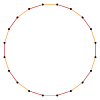 t{10}={20} |
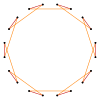 |
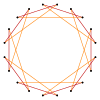 |
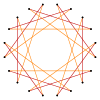 |
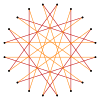 |
 t{10/9}={20/9} |
 t{10/3}={20/3} |
 |
 |
 |
 |
 t{10/7}={20/7} |
Petrie polygons
The regular icosagon is the Petrie polygon for a number of higher-dimensional polytopes, shown in orthogonal projections in Coxeter planes:
| A19 | B10 | D11 | E8 | H4 | 2H2 | ||
|---|---|---|---|---|---|---|---|
 19-simplex |
 10-orthoplex |
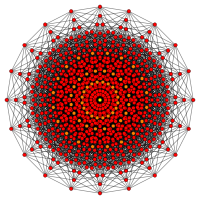 10-cube |
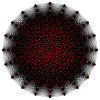 11-demicube |
 (421) |
 600-cell |
 10-10 duopyramid |
 10-10 duoprism |
It is also the Petrie polygon for the icosahedral 120-cell, small stellated 120-cell, great icosahedral 120-cell, and great grand 120-cell.
References
- ↑ Muriel Pritchett, University of Georgia "To Span the Globe", see also Editor's Note, retrieved on 10th January 2016
- ↑ Weisstein, Eric W., "Icosagon", MathWorld.
- ↑ John H. Conway, Heidi Burgiel, Chaim Goodman-Strauss, (2008) The Symmetries of Things, ISBN 978-1-56881-220-5 (Chapter 20, Generalized Schaefli symbols, Types of symmetry of a polygon pp. 275-278)
- ↑ The Lighter Side of Mathematics: Proceedings of the Eugène Strens Memorial Conference on Recreational Mathematics and its History, (1994), Metamorphoses of polygons, Branko Grünbaum
| ||||||||||||||||||||||||||
